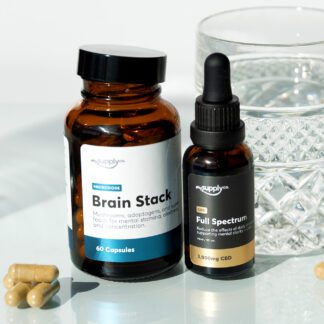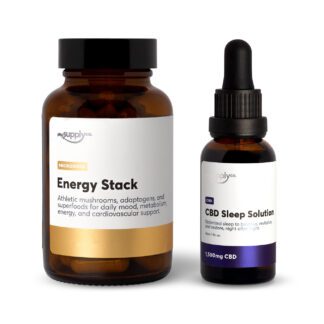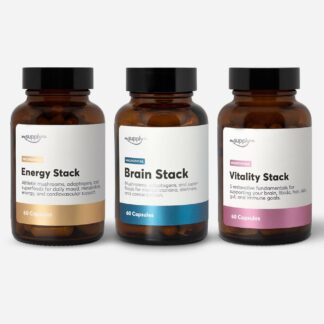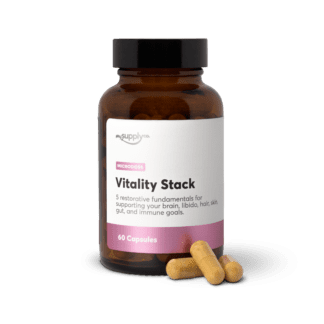Side effects, long-term use health complications, tolerance and dependence, ineffective medication, the desire for natural alternatives—there are probably a lot of reasons you want to stop taking your ADHD meds.
At the same time, you wouldn't be taking them if your mind wasn't a bustling marketplace, thoughts darting around like fireflies, never settling. Every sound, every movement, magnets pulling your attention away. It's like trying to catch a cloud, fleeting and impossible, as you navigate a world that's always one step ahead.
In this article, I'm going to share, step-by-step, how my girlfriend weaned off of her ADHD meds (Vyvance, in her case) by microdosing.
And it only took her a month.
Hopefully, you can too.
Now, a little background on her ADHD.

Microdosing mushrooms for ADHD: How it Started.
For her, brain fog and energy dips are characteristic. Brain fog was especially obvious in periods of high stress — but usually, it manifests more as scattered thoughts than brain fog.
"I think I have too many thoughts racing. I experience things like difficulty concentrating and mental clarity issues, and as you know, forgetfulness. Idk about my low energy, this seems like a new development from the past year. Historically, before I was on meds and even when I would take time off meds, I never had issues with low energy, and it was quite the opposite actually."
Naturally, I worried about what they were doing to my girlfriend. So, I suggested microdosing.
She was skeptical at first; she's a nurse and wasn't going to be easily convinced to stop taking her ADHD meds.
So I shared my research about the benefits of microdosing psilocybin, and she did her own.
She was in.
But it didn't work for her overnight.
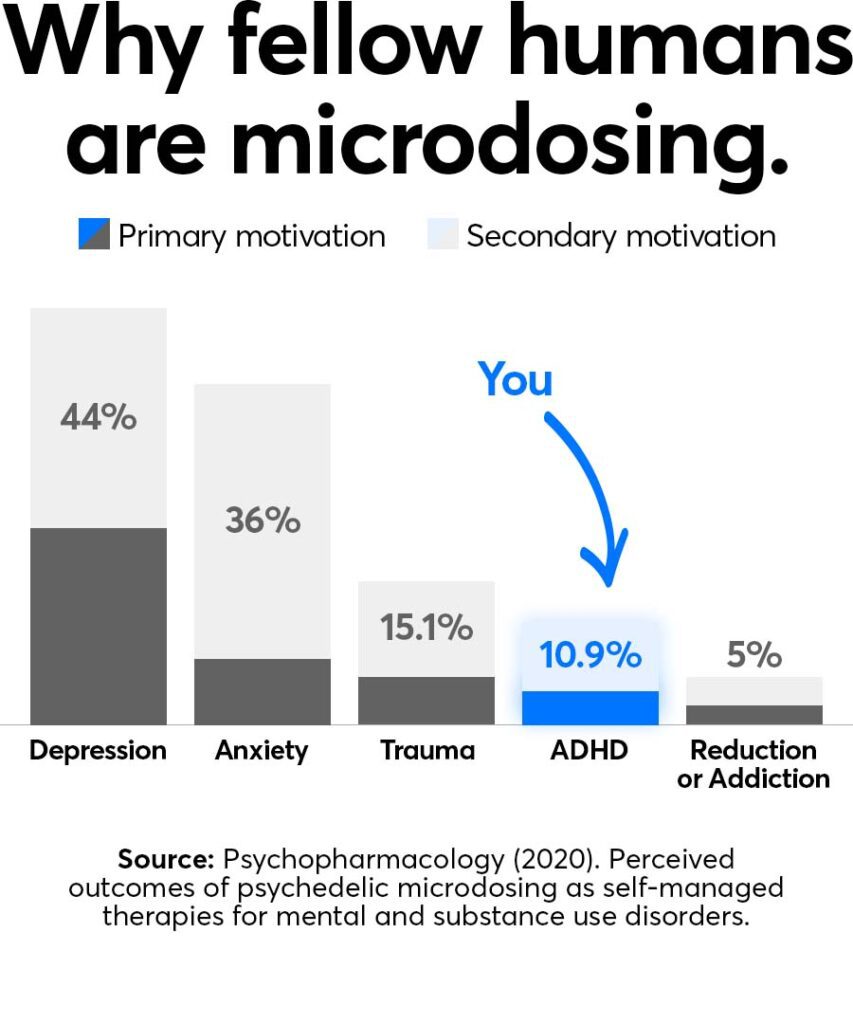
When she started microdosing, she quit her ADHD meds cold turkey. That was fine on microdose days, but on non-microdose days she would experience a significant energy dip. So, she continued her weekly schedule of 4 days of microdosing followed by 3 days without one, instead taking her ADHD meds as needed on those 3 days.
At first, those were all her non-microdosing days. There were even some microdosing days when she felt like she needed the boost. But, over time, she found that she only needed them on two of her non-microdosing days, then one, and eventually, she was only rarely taking them to keep her up on her long and grueling night shifts as a nurse.
Today, months later, she no longer needs to microdose mushrooms for her ADHD.
For her, transitioning from traditional ADHD medication to microdosing psilocybin was a transformative journey, offering a more holistic approach to managing ADHD symptoms, brain fog, and energy dips.
Below is the step-by-step process based on my girlfriend's successful experience:

The step-by-step guide to weaning off ADHD meds with the help of magic mushrooms.
Step 1: Consult a Healthcare Professional:
Before making any changes, consult a healthcare professional or trusted therapist, preferably one familiar with both ADHD and holistic approaches. They can guide you how to safely transition and monitor your progress. Check out our in-depth directory of psychedelic therapy clinics in Canada to find a therapist near you.
Step 2: Understanding Your Symptoms:
Identify your specific ADHD symptoms, brain fog triggers, and energy level fluctuations. Write them down. This self-awareness will help tailor the microdosing approach to your unique needs, especially in Step 4 and beyond.
Step 3: Source Your Magic Mushrooms:
Ensure you have a reliable source of dried magic mushrooms or pre-packaged microdose formulas.
At My Supply Co., we offer three formulas: Brain Stack, Energy Stack, and Vitality Stack. Each is formulated with the P. cubensis strain of psilocybin mushrooms plus nature's most powerful ingredients. My girlfriend was supplementing with Vitality Stack.
Step 4: Start the Transition:
Remember to practice safe and responsible use of psilocybin. Just because you're doing it for your ADHD doesn't mean that it can't whoop you into shape if you aren't mindful of your dose.
We do not recommend using a potent strain. You'll want something predictable and consistent. We recommend starting as low as 25mg of dried P. cubensis, ideally of the Golden Teacher strain or one of our microdose formulas.
Read: How to Choose a Mushroom Strain & How to Use Them Therapeutically

Begin the transition by following a structured schedule:
- Week 1 - 2: Establish Baseline: Follow a microdosing schedule of 4 days on followed by 3 days off. Microdose early in the morning, and take note of the doses, the intensity of your ADHD symptoms on microdose days, and any observable changes on non-microdose days. Resist taking your ADHD meds on microdose days, but if you must, take them after at least 3 - 4 hours have passed. I know this sounds like a monumental effort, but microdosing is about working with intention and integrating your expanded consciousness into new, helpful behaviours. I believe in you.
- Week 3-4: Decrease Medication Frequency: Gradually reduce the days you take your ADHD medication. If you were initially taking it on all your off days, try taking it on only two out of three off days.
- Week 5-6: Further Medication Reduction: As you adapt to microdosing, aim to take your ADHD medication on only 1 out of 3 off days.
Step 5: Evaluate and Adjust:
Regularly assess your energy levels, focus, and overall well-being. Adjust your microdosing schedule and medication usage based on how you feel. Note any improvements in brain fog and energy dips.
Step 6: Optimize Microdose Formulas:
Experiment with different formulas if needed. For example, Energy Stack with Cordyceps, Matcha, and Vitamin B3 can provide a smoother energy boost and enhanced focus without jitters. Tailor your choice to your preferences and needs.
Step 7: Fine-Tuning the Microdosing Schedule:
Continue adjusting your microdosing schedule based on your evolving needs:
- Week 7-8: As you experience positive effects, try reducing microdosing days to find the minimum effective dose. This might be 3 days on and 4 days off.
- Week 9 onwards: Gradually extend the duration between microdosing days. Some individuals find a maintenance schedule of microdosing once every 7-10 days sufficient to manage symptoms.
Step 8: Monitor Mindfully:
Regularly reflect on your progress and consult your healthcare professional. Keep track of improvements in focus, energy, and brain fog, as well as any challenges you encounter.
Step 9: Upgrade Your Lifestyle:
Support your transition with a healthy lifestyle. Prioritize sleep, exercise, a balanced diet, and stress management techniques like mindfulness and meditation.
Read: The Science of Self-Awareness: How Meditation and Psilocybin Shape the Brain
Step 10: Ongoing Self-Care:
Maintain open communication with your healthcare professional and make adjustments as needed. Remember that everyone's journey is unique; stay patient and committed to finding the optimal approach for your well-being.
Conclusion
Transitioning from traditional ADHD medication to microdosing psilocybin requires careful planning, observation, and a commitment to holistic well-being. By following this step-by-step guide and staying attuned to your body's signals, you can achieve improved focus, reduced brain fog, and sustained energy levels.
And remember, always prioritize your health and consult professionals when making changes to your treatment plan.
Microdosing psilocybin for ADHD FAQs.
-
What is microdosing mushrooms for ADHD, and how does it work?
Microdosing mushrooms for ADHD involves taking very small, sub-perceptual doses of psilocybin-containing mushrooms on a regular schedule. It is believed to work by influencing serotonin receptors and increasing focus and mood stability.
-
Has microdosing psilocybin been scientifically proven to help with ADHD?
According to a 2020 study, over 11% of those microdosing medicinally do so for anxiety. There is ample anecdotal evidence suggesting that microdosing mushrooms may benefit some individuals with ADHD, but there have been no studies investigating the use of psilocybin mushrooms for ADHD specifically. More research is needed to determine its effectiveness and safety for this purpose. However, research on the different effects psilocybin has on the brain indicates that it may be helpful for bringing the focus, clarity, and calm alertness needed to better manage one's ADHD.
-
Why try microdosing mushrooms for ADHD?
The article explains my girlfriend's personal motivations, but common reasons include seeking alternatives to traditional ADHD medications, concern about side effects, and a desire for improved focus and emotional well-being.
Because this article shares personal outcomes, it's important to note that individual experiences can vary widely. Some people report improved focus, reduced impulsivity, and better mood, while others may not see significant benefits.
-
How can I safely try microdosing mushrooms for ADHD?
We strongly emphasize the importance of responsible and informed experimentation. This includes careful preparation and intention-setting, starting with very low doses, maintaining a consistent schedule, and monitoring for any adverse effects. Speak to a health care professional, and check out our directory of psychedelic therapists to get the most out of your psilocybin experience.
-
Would you recommend any non-psychedelic mushrooms for ADHD?
Lion's Mane mushroom is a powerful ally for your everyday well-being, but especially for brain function and performance. It shares many benefits with psilocybin mushrooms, and is particularly known for its benefits for memory, sleep, and gut health. You can find Lion's Mane in Brain Stack, our master nootropic microdose formula.
-
Can I mix mushrooms with other medications?
If you are taking antidepressants, you and your healthcare provider can work out a schedule that allows you to microdose. This may involve microdosing after a certain number of hours since your antidepressant dose have passed, or may involve alternating days.
Shop microdose supplements.
-
 3060
3060
Brain Stack | Microdose Capsules
Optimal Cognition + Brain Health
-
 3060
3060
Energy Stack | Microdose Capsules
Energy + Mood + Brain Function
-
 20% OFF
20% OFF
Unstress Stacks → Balance + Resilience
Thrive Under Stress. Cellular Rejuvenation, Healthy Inflammation, & Immunity
-
 20% OFF
20% OFF
Unstress Stacks → Calm + Clear Duo
Nootropic regimen for daily calm, focus, memory, and mental adaptability
-
 20% OFF
20% OFF
Unstress Stacks → Glow to Sleep
Stress + Energy + Sleep + Brain Health
-
 20% OFF
20% OFF
Unstress Stacks → The Trinity
Brain Stack + Energy Stack + Vitality Stack
-
 3060
3060
Vitality Stack | Microdose Capsules
Age Backwards



